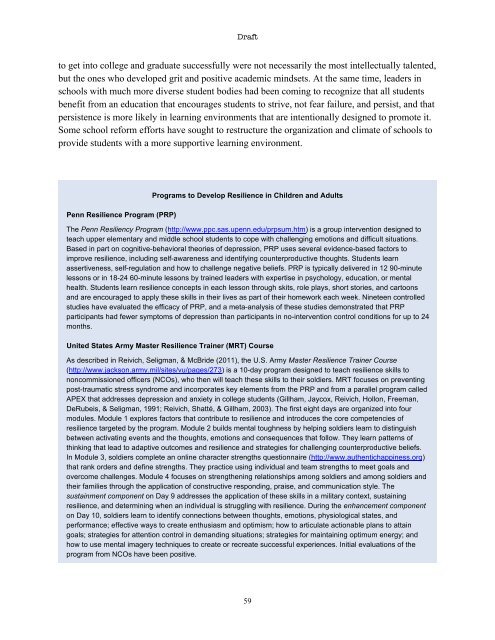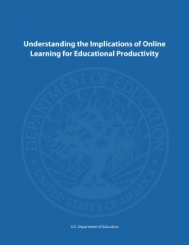Promoting Grit, Tenacity, and Perseverance - U.S. Department of ...
Promoting Grit, Tenacity, and Perseverance - U.S. Department of ...
Promoting Grit, Tenacity, and Perseverance - U.S. Department of ...
You also want an ePaper? Increase the reach of your titles
YUMPU automatically turns print PDFs into web optimized ePapers that Google loves.
Draft<br />
to get into college <strong>and</strong> graduate successfully were not necessarily the most intellectually talented,<br />
but the ones who developed grit <strong>and</strong> positive academic mindsets. At the same time, leaders in<br />
schools with much more diverse student bodies had been coming to recognize that all students<br />
benefit from an education that encourages students to strive, not fear failure, <strong>and</strong> persist, <strong>and</strong> that<br />
persistence is more likely in learning environments that are intentionally designed to promote it.<br />
Some school reform efforts have sought to restructure the organization <strong>and</strong> climate <strong>of</strong> schools to<br />
provide students with a more supportive learning environment.<br />
Penn Resilience Program (PRP)<br />
Programs to Develop Resilience in Children <strong>and</strong> Adults<br />
The Penn Resiliency Program (http://www.ppc.sas.upenn.edu/prpsum.htm) is a group intervention designed to<br />
teach upper elementary <strong>and</strong> middle school students to cope with challenging emotions <strong>and</strong> difficult situations.<br />
Based in part on cognitive-behavioral theories <strong>of</strong> depression, PRP uses several evidence-based factors to<br />
improve resilience, including self-awareness <strong>and</strong> identifying counterproductive thoughts. Students learn<br />
assertiveness, self-regulation <strong>and</strong> how to challenge negative beliefs. PRP is typically delivered in 12 90-minute<br />
lessons or in 18-24 60-minute lessons by trained leaders with expertise in psychology, education, or mental<br />
health. Students learn resilience concepts in each lesson through skits, role plays, short stories, <strong>and</strong> cartoons<br />
<strong>and</strong> are encouraged to apply these skills in their lives as part <strong>of</strong> their homework each week. Nineteen controlled<br />
studies have evaluated the efficacy <strong>of</strong> PRP, <strong>and</strong> a meta-analysis <strong>of</strong> these studies demonstrated that PRP<br />
participants had fewer symptoms <strong>of</strong> depression than participants in no-intervention control conditions for up to 24<br />
months.<br />
United States Army Master Resilience Trainer (MRT) Course<br />
As described in Reivich, Seligman, & McBride (2011), the U.S. Army Master Resilience Trainer Course<br />
(http://www.jackson.army.mil/sites/vu/pages/273) is a 10-day program designed to teach resilience skills to<br />
noncommissioned <strong>of</strong>ficers (NCOs), who then will teach these skills to their soldiers. MRT focuses on preventing<br />
post-traumatic stress syndrome <strong>and</strong> incorporates key elements from the PRP <strong>and</strong> from a parallel program called<br />
APEX that addresses depression <strong>and</strong> anxiety in college students (Gillham, Jaycox, Reivich, Hollon, Freeman,<br />
DeRubeis, & Seligman, 1991; Reivich, Shatté, & Gillham, 2003). The first eight days are organized into four<br />
modules. Module 1 explores factors that contribute to resilience <strong>and</strong> introduces the core competencies <strong>of</strong><br />
resilience targeted by the program. Module 2 builds mental toughness by helping soldiers learn to distinguish<br />
between activating events <strong>and</strong> the thoughts, emotions <strong>and</strong> consequences that follow. They learn patterns <strong>of</strong><br />
thinking that lead to adaptive outcomes <strong>and</strong> resilience <strong>and</strong> strategies for challenging counterproductive beliefs.<br />
In Module 3, soldiers complete an online character strengths questionnaire (http://www.authentichappiness.org)<br />
that rank orders <strong>and</strong> define strengths. They practice using individual <strong>and</strong> team strengths to meet goals <strong>and</strong><br />
overcome challenges. Module 4 focuses on strengthening relationships among soldiers <strong>and</strong> among soldiers <strong>and</strong><br />
their families through the application <strong>of</strong> constructive responding, praise, <strong>and</strong> communication style. The<br />
sustainment component on Day 9 addresses the application <strong>of</strong> these skills in a military context, sustaining<br />
resilience, <strong>and</strong> determining when an individual is struggling with resilience. During the enhancement component<br />
on Day 10, soldiers learn to identify connections between thoughts, emotions, physiological states, <strong>and</strong><br />
performance; effective ways to create enthusiasm <strong>and</strong> optimism; how to articulate actionable plans to attain<br />
goals; strategies for attention control in dem<strong>and</strong>ing situations; strategies for maintaining optimum energy; <strong>and</strong><br />
how to use mental imagery techniques to create or recreate successful experiences. Initial evaluations <strong>of</strong> the<br />
program from NCOs have been positive.<br />
59
















